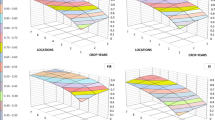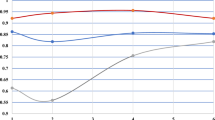Summary
Two experiments, each involving a set of 10 sweet potato clones, were conducted for three years at 4 sites (Ekona, Ebolowa, Nkolbisson, and Bambui Plain) in Cameroon. Data obtained were subjected to analysis of variance to determine the presence of genotype x environment (G x E) interactions, and to regression analysis to assess the performance of clones across anvironments. Environments were assessed in two ways: (i) the mean response of all clones (dependent assessment), and (ii) the average performance of a different set of clones (independent assessment).
The first experiment (Expt 1) produced higher yields but had fewer stable clones than the second (Expt 2).
The analysis of variance revealed that the clones interacted significantly with environments for all traits.
The study has identified high yielding and stable sweet potato clones for distribution to growers in the major areas of cultivation in the tountry. Despite slight differences in numbers of clones judged stable by the various regression indices in the two methods of environmental assessments, the rankings of clones on the basis of their linear regression coefficients were similar. In a developing country like Cameroon, with limited resources and where sophisticated equipment for obtaining physical or biological measures of the environment may be lacking, the mean performance of genotypes may still be the most reliable measure of environment in evaluating the stability of performance of crop cultivars.
Similar content being viewed by others

References
Breese, E.L., 1969. The measurement and significance of genotype-environment interaction in grasses. Heredity 24: 27–44.
Collins, W.W., L.G. Wilson, S. Arrendell & L.F. Dickey, 1987. Genotype x environment interaction in sweet potato yield and quality factors. J. Amer. Soc. Hort. Sci. 112: 579–583.
Eberhart, S.A. & W.A. Russell, 1966. Stability parameters for comparing varieties. Crop Sci. 6: 36–40.
Finlay, K.W. & G.N. Wilkinson, 1963. The analysis of adaptation in a plant-breeding programme. Australian J. of Agric. Res. 14: 742–754.
Freeman, G.H., 1973. Statistical methods for the analysis of genotype-environment interactions. Heredity 31: 339–354.
Freeman, G.H. & J.M. Perkins, 1971. Environmental and genotype environmental components of variability. VIII. Relations between genotypes grown in different environments and measures of these environments. Heredity 27: 15–23.
Fripp, Y.J., 1972. Genotype-environment interactions in Schizophyllum commune. II. Assessing the environment. Heredity 27: 223–238.
Fripp, Y.J. & C.E. Caten, 1971. Genotype-environment interactions in Schizophyllum commune. Heredity 27: 223–238.
Hardwick, R.C. & J.T. Wood, 1972. Regression methods for studying genotype-environment interactions. Heredity 28: 209–222.
Hill, J., 1975. Genotype-environment interactions-a challenge for plant breeding. J. Agric. Sci. (Camb.) 85: 477–493.
Hill, J. & C.J.A. Samuel, 1971. Measurement and inheritance of environmental response amongst selected material of Lolium perenne. Heredity 27: 265–276.
Kaltsikes, P.J. & E.N. Larter, 1970. The interaction of genotype and environment in durum wheat. Euphytica 19: 236–242.
Kanua, M.B. & C.N. Floyd, 1988. Sweet potato genotype x environment interactions in the highlands of Papua New Guinea. Trop. Agric. (Trin.) 65: 9–16.
Knight, R., 1970. The measurement and interpretation of genotype-environment interactions. Euphytica 19: 225–235.
Ng, T.J., C.A. McClurg, F.F. Angell & J.I. Anderson, 1980. Evaluation of muskmelon cultivar performance by joint regression analysis. J. Amer. Soc. Hort. Sci. 105: 220–223.
Perkins, J.M. & J.L. Jinks, 1973. The assessment and specificity of environmental and genotype-environmental components of variability. Heredity 30: 111–126.
Shukla, G.K., 1972. Some statistical aspects of partitioning genotype-environmental components of variability. Heredity 29: 237–245.
Snoad, B. & A.E. Arthur, 1976. The use of regression techniques for predicting the response of peas to environment. Theor. Appl. Genet. 47: 9–19.
Steel, R.G.D. & J.H. Torrie, 1980. Principles and procedures of statistics—A biometrical approach. 2nd ed. McGraw Hill, Inc., New York.
Tan, Wai-Koon, Geok-Yong, Tan & P.D. Walton, 1979. Regression analysis of genotype-environment interaction in smooth bromegrass. Crop Sci. 19: 393–396.
Troughton, A., 1970. Intra-varietal variation of yield in two varieties of Lolium perenne L.. Euphytica 19: 382–389.
Witcombe, J.R. & W.J. Whittington, 1971. A study of the genotype by environment interaction shown by germinating seeds of Brassica napus. Heredity 26: 397–411.
Yates, F. & W.G. Cochran, 1938. The analysis of groups of experiments. J. Agric. Sci. (Camb.) 28: 556–580.
Author information
Authors and Affiliations
Rights and permissions
About this article
Cite this article
Ngeve, J.M. Regression analysis of genotype x environment interaction in sweet potato. Euphytica 71, 231–238 (1993). https://doi.org/10.1007/BF00040412
Received:
Accepted:
Issue Date:
DOI: https://doi.org/10.1007/BF00040412



